EC5. Carbon in the Biosphere
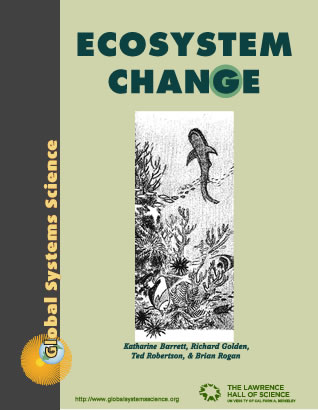
Chapter 5
I. The Carbon Dioxide Cycle
When we enjoy the beauty of a tree we probably aren’t thinking of this marvelous structure as a carbon-based system that transforms sunlight and gases into food. A single cell in a tree leaf is a tiny system that uses light energy plus water and carbon dioxide from the air to produce sugar. During this process oxygen and water are also produced by the cell. All life on the planet depends on this very commonplace but remarkable process known as photosynthesis.
In order to use the chemical energy stored in sugar molecules, cells must use oxygen to break down the sugar. Carbon dioxide and water are produced and heat energy is released as the sugar is used. This process is known as respiration, and it goes on night and day while the cells are alive.

Cells need more than the energy from sugar. They use other nutrients and minerals to repair tissue and to produce new cells for growth and reproduction. Overall, a healthy tree produces more oxygen than it uses during the year, and takes in large amounts of carbon dioxide while growing roots, trunk, branches, leaves, fruits or cones, and seeds.
II. The Tree As a System
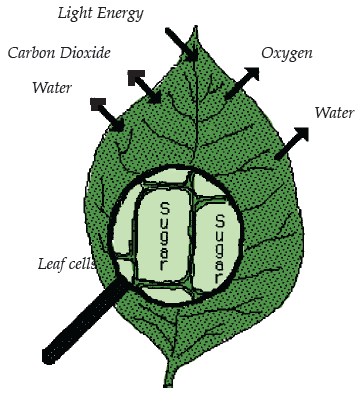
Plants remove CO2 from the atmosphere and convert it to organic molecules that can be used by all living things. In the more than 3 billion years that photosynthetic organisms have been operating on Earth, they have removed vast quantities of CO2 from the atmosphere and oceans. Why hasn’t the carbon dioxide been used up?
As the leaves of a tree produce sugar molecules, other areas of the plant use the sugar for various life functions. While chemical energy is being produced by the plant, the tissues of the plant are also using the energy in a process known as respiration. The great majority of living organisms, including plants, animals, and many bacteria, use sugar for their energy and release carbon dioxide back into the atmosphere.
This is a simplified chemical equation for photosynthesis in green plants:
CO2 + 2H2O + Sun’s energy ⇒ CH2O + H2O + O2
Respiration in plants and animals as they “burn” sugar to get energy:
CH2O + H2O + O2 ⇒ CO2 + 2H2O + ENERGY FOR LIFE
If all of the sugar produced during photosynthesis is used for energy then all of the carbon dioxide is returned to the atmosphere. However, when growing conditions are good for the plant, it will produce far more sugar than it needs just to maintain itself. The excess can then be stored by the plant or used for growth and reproduction.
Over millions of years, animals have evolved many ways of getting and using plant sugars. Likewise, plants have evolved numerous ways protecting themselves from being eaten.
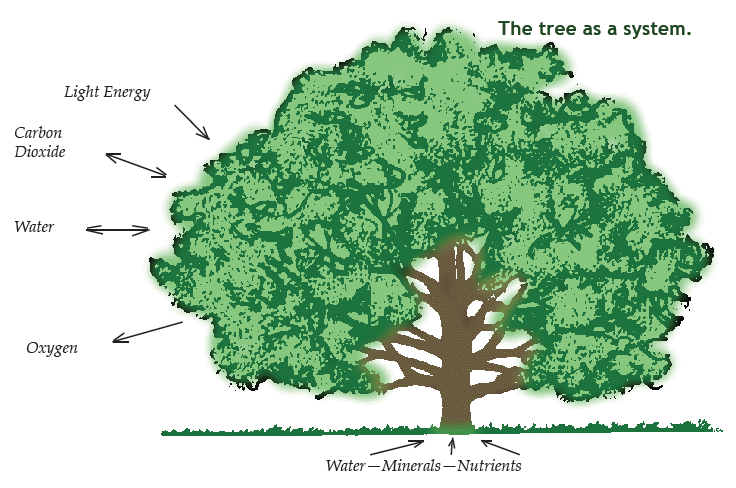
III. What On Earth Is Carbon?
Carbon in the atmosphere is found mainly in the form of carbon dioxide gas (CO2). It enters the atmosphere from several sources and is removed or stored by a number of processes which are referred to as “carbon sinks.”
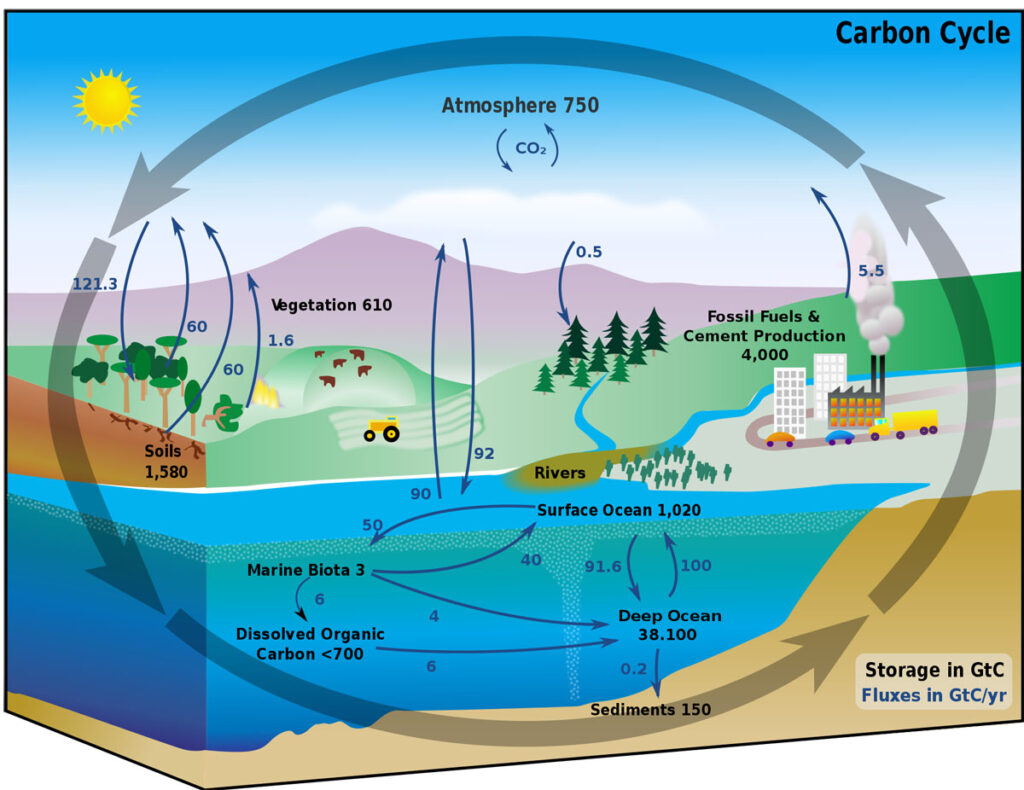
This diagram shows amounts of carbon that are stored in various “carbon sinks” and how much transfers between sinks on a regular basis. Via Wikimedia Commons.
On land, carbon is stored in the tissues of plants and animals and as deposits of dead materials in soil. In bedrock, carbon is found in coal, oil, shale, and limestone deposits. In the ocean, carbon is found in the bottom deposits of organic mud and dissolved in the water as ions called carbonates (CO3– ).
What are the feedback mechanisms that affect the level of carbon dioxide in the atmosphere?
Let’s trace the carbon pathway between the atmosphere, land, and the ocean. Before industrialization, the primary sources of atmospheric carbon dioxide were respiration from plants and animals, volcanic eruptions, decomposition, and combustion from natural and human caused fires. You breathe in air containing oxygen, carbon dioxide and other gases, and exhale air with a higher concentration of carbon dioxide and a lower concentration of oxygen.
IV. Trees By the Billions
Ecologist Richard Houghton of Woods Hole Research Center in Massachusetts calculates that the burning of tropical forests is pumping about 2.4 billion tons of carbon into the atmosphere each year. This is .6 billion tons more per year than ten years ago.
It is the carbon connection that has led ecologists and economists to propose massive tree planting efforts in the tropics. According to the World Bank and the U.N. Food and Agriculture Organization, one acre of the fastest growing trees used for tropical tree plantations generates an estimated 8 tons of wood each year, thereby storing 4 tons of carbon.
Ecologist Norman Myers has proposed a combination of forest preservation and reforestation as a potential method for curbing the greenhouse effect. He estimates that to soak up one billion tons of carbon, we would need to plant 400,000 square miles of fast-growing trees.
Dr. Meyers points out that an example has already been initiated by a public-spirited utility company in Connecticut. The company is building a new power plant that will emit 15.5 million tons of carbon during its 40-year life. To compensate for the projected carbon release, it is also funding the planting of 52 million trees in 400 square miles of Guatemala.
V. Cooling Our Cities
Over the last several decades, Atlanta, Georgia, has become one of the largest areas of commercial and industrial development in the southeastern United States. This rapid growth has made Atlanta one of the fastest growing urban areas in the country. The population has increased over 25% since 1970 and over 30% just in the last ten years.
To accommodate this growth, the city has expanded to a diameter of over 60 miles, consuming vast areas of former agricultural/rural land that formerly surrounded the city.
Two results of this explosive growth have been an increase in the unhealthy air in the area and a significant difference in the temperature between the city and the rural area around it. This phenomenon creates an “Urban Heat Island.”

Urban sprawl in Atlanta Over time
Many cities in the United States experience this phenomenon. This trend may cost your city a lot of money because the cost of cooling increases 1.5% for every 0.6°C (1°F). As an example, in Washington, DC, air conditioners run for about 1300 hours a year. This costs ratepayers about $40,000 for each hour or about $2,000,000 a year! (http://www.epa.gov/heatisland/)
Atlanta is one of many cities to realize that the loss of trees surrounding and within the city has contributed to the rise in temperature and the loss of air quality over the last few decades. In Tucson, Arizona, the Trees for Tucson program encourages people to plant trees and provides information on appropriate trees to plant and where to put them to be the most effective in reducing energy use.
Tree planting is a simple way to counter the urban heat island effect. Trees cool by shading and from evapotranspiration or the release of w http://commons.wikimedia.org/wiki/File:Peat_artisanal_exploitation2.jpg ater vapor by trees. The energy savings from tree planting can be significant with an average of 20-25% reduction in costs.
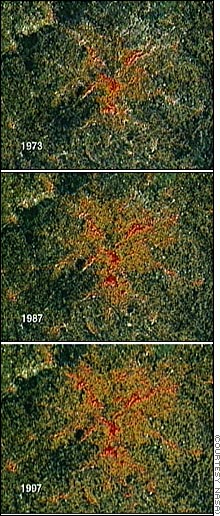
VI. The Tree Musketeers
El Segundo, a city adjacent to Los Angeles, is home to several large oil refineries and chemical factories. A major highway and the Los Angeles International Airport lie within the city limits. It is a city surrounded by polluting industries. The students who go to school in El Segundo have first-hand experience with environmental degradation.
Thirteen eight-year-old students were attending school in El Segundo in 1987 and were learning about loss of the world’s forests, the depletion of ozone in our atmosphere and pollution of the earth’s air and water. These students decided to take action on their own!
Their first project was to plant a tree that they named “Marcie the Marvelous.” Sitting in the shade of their newly planted tree, they debated what to do next. Using the collective genius that a cooperative group of people can generate, these students formed an environmental action group called the Tree Musketeers. They easily enlisted the aid of other enthusiastic friends and began a series of projects to improve the environment of their local community.
Here are some of the projects the Tree Musketeers accomplished in less than four years:
- Planted hundreds of trees in their community and around local industries to form living screens that help absorb air pollutants
- Established the city’s first complete recycling drop-off to reduce the amount of garbage in the dumps and to slow consumption of the earth’s resources
- Worked to re-establish the native vegetation for the severely endangered species, the El Segundo Blue butterfly, whose habitat has been reduced to two acres
- Taught other students and youth groups about safe products as alternatives to environmentally harmful and hazardous chemicals used in the home, and persuaded local stores to carry these “green” products
- Educated the public by publishing a regular column in the newspaper and by producing an environmental quiz show called “Tree Stumper” for the local cable network.
This is only a partial list of this group’s actions. They have avoided negative confrontations and finger pointing. Instead, they have chosen to take action and deliver positive messages through projects that directly benefit the community. They have enlisted help from large industries for projects that benefit the environment.
Estimate the tree canopy of your school or neighborhood, then develop a plan with your friends to increase the tree cover by 50%.
VII. Carbon Sinks
When plants and animals die, their tissues are decomposed by bacteria and fungi, which release carbon, nitrogen and other nutrients. Some of the free carbon becomes locked up in the soil. When animals eat plants, the carbon in the plants is changed to other forms inside the animal’s body. A very small percentage of the world’s carbon is stored inside animal tissues.
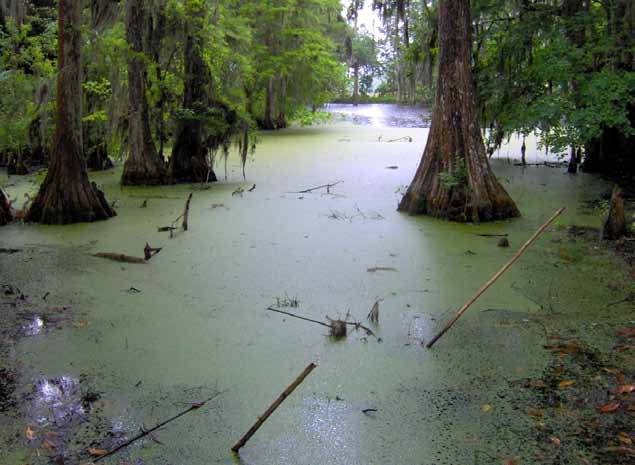
http://commons.wikimedia.org.
As algae and other plants growing in oceans, ponds and marshes die, the vegetation sinks to the bottom. Because these bottom areas are anaerobic, meaning that they lack free oxygen, decomposition is inhibited.
The sediments containing carbon accumulate to form large deposits at the bottom of these waters. Coal mined in the world today formed by this very process. During the carboniferous period, 400 million years ago, large stands of ancient forests grew and died in swampland, adding layer upon layer of carbon. This carbon was buried by other sediments and later compressed into coal.
Tundra ecosystems, found around the polar regions and at high mountain elevations, are areas where large deposits of organic matter have formed. When plants growing in these frozen environments die, they accumulate layer after layer, eventually forming peat bogs. People in the British Isles, Northern Europe and the Arctic have a long history of mining and burning peat as fuel for their homes.
VIII. Carbon Beneath the Forests
In the temperate forests of the world, leaves, pine needles, fruits, cones, and other debris that have fallen from the canopy build up, forming a rich layer of organic material. This deposit of carbon-rich plant material is home to a myriad of small invertebrates, fungi and microorganisms that feed on the cellulose and animal matter, thereby returning many of the nutrients to the soil.
Decomposition and decay are processes that most of us try to avoid! Dead things smell when they break down and look weird and scary. For all its unpleasant aspects, organic decomposition is essential to the well-being of life on Earth. The nutrients and energy within living things get passed on to future generations of organisms via the hidden world of scavengers and decomposers. In your lifetime, you will eat about 50 tons of “second hand” food made up of recycled nutrients! The unappreciated “realm of the rotten” can provide fascinating observations of changes in soil, vegetation, and organic matter.
Tropical rain forests have small amounts of dead organic matter (humus) in their soils, which are composed mostly of clay. Temperate forests have a well developed layer of organic humus in their soils. In the following activity, observe changes in foods and organic materials as you test the affects of temperature on the process of decomposition.

EC5.1. Investigation:
Decomposition In a Bag
Investigate the role of temperature in decomposition.
What You Need
| Moist Items | Dry Items |
|---|---|
| carrot | uncooked beans |
| apple | uncooked pasta |
| lettuce or spinach | popped popcorn |
| natural bread | unpopped popcorm |
| cooked pasta | matzo cracker |
| grass clippings | dead leaves |
Getting Started
- State your hypothesis about the effect of temperature on decomposition.
- Outline an experiment to test your hypothesis. Sketch your setup.
- List the factors that you will control in your experiment.
- 4Monitor your experiment over a two-week period. Keep a daily log.
Describe Your Results and Conclusions
If Earth’s climate warms, what do you predict will happen to the rate of decomposition in the temperate forests of the world? How might this affect the level of CO2 in the atmosphere?

